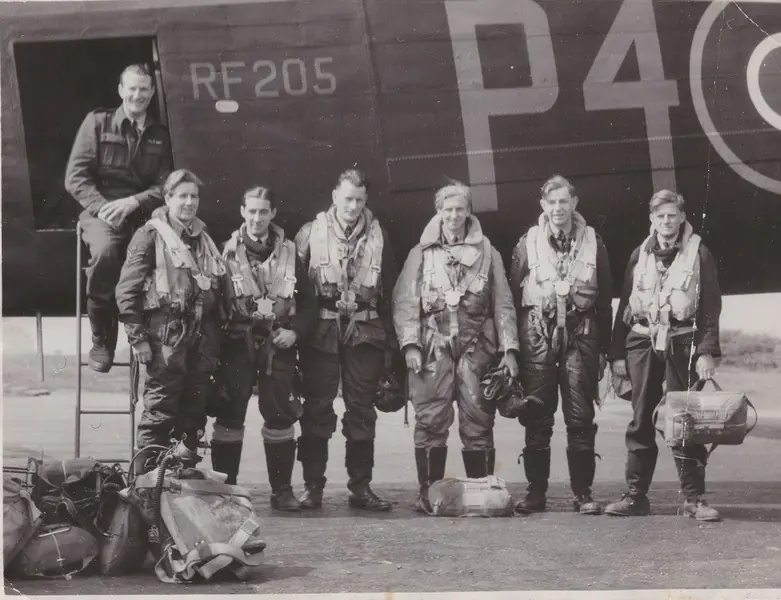HISTORY OF BOMBER COMMAND
RAF Bomber Command was created in 1936. At the start of World War II in September 1939, it had only 280 twin-engined aircraft, 23 operational squadrons and just 15,000 personnel. As the war progressed, however, the addition of heavy aircraft, combined with increased scope and manpower, led to it taking a pivotal role in some of the longest and most expensive campaigns of the war. By September 1944, around a quarter of a million men and women were putting over 1,600 aircraft in the air every night, in an effort to bring the war to an end.
The loss of life was enormous and replacement aircrew, from more than 60 countries across the world and from all walks of life, were continually recruited and trained to help keep Bomber Command in the air. They were all volunteers and most came from across the Commonwealth and occupied Europe, even Germany, having escaped the Nazi regime. As the war progressed, members of the Air Forces of Poland, Canada, Australia and New Zealand all joined the bomber crews, and it was common to have squadrons comprising numerous nationalities.

During the first stages of World War II, both sides initially tried precision daylight attacks on military installations. However, it soon became clear that bomber aircraft and their crews were in far more danger from fighters and anti-aircraft fire than expected, and that these daylight raids had little effect. Flying under the cover of darkness became essential to avoid being shot down, but this brought with it enormous challenges of night navigation and target finding; it is estimated that early in the war only one in 20 bombs fell within 5 miles (8 km) of its target, and many aircraft would set out to attack and be almost destroyed before reaching their target.
In May 1940, a highly controversial ‘Area Bombing Directive’ was authorised by Churchill’s Cabinet and Bomber Command began to fly campaigns against the German Navy, the industries of the Ruhr Valley, various German cities, and V1 and V2 missile launch sites, such as at Peenemünde.
To carry out this new mandate, additional RAF stations were built all over the UK, each with the population of a large village, and a new Commander-in-Chief was appointed for Bomber Command, Air Marshal Arthur ‘Bomber’ Harris. He promised to make the German people ‘reap the whirlwind’ and this pledge resonated with a desire to strike back at the mighty Nazi war machine. Harris firmly believed that with improved aircraft, such as the Lancaster and Halifax, better training and navigational aids, combined with a renewed will to attack, Bomber Command could knock Germany out of the war.
In May 1942, Harris launched his first ‘thousand-bomber raid’ against Cologne. A year later, the famous ‘Dambusters’ raid by 617 Squadron on the dams surrounding the Ruhr Valley, proved that precision strikes were now feasible with modern four-engine bombers and new tactics. Aerial bombing had become a crucial weapon of war, and Bomber Command’s crews and support staff were playing a vital role in ensuring that Nazi Germany’s military machine was severely weakened, by disrupting its workforce and capacity to produce more weapons.
From 1943, the US Eighth Air Force joined the RAF in a round-the-clock offensive, launching a series of huge raids on Berlin, with the aim of reducing Germany’s morale and resistance, in order to bring an early end to the war. In November of that year, Harris launched an airborne bombing campaign on the city that lasted until March 1944. This became known as the ‘Battle of Berlin’, although attacks were not solely limited to Berlin, which endured 16 massive raids, but on other German cities too. Between 22 and 23 November, 469 Lancasters, 234 Halifaxes, 50 Stirlings and 11 Mosquitos (764 bombers in total) dropped 2,300 tons of bombs in 30 minutes, killing 2,000 Berliners and rendering 175,000 homeless. The following night, 1,000 more Berliners were killed and 100,000 more rendered homeless. Regular raids continued between December 1943 and January 1944, killing hundreds of people and leaving between 20,000 and 80,000 homeless each time.
The losses to RAF Bomber Command were also devastating. During 9,111 sorties against Berlin, which often involved return trips of more than 1,000 nautical miles, 492 aircraft were lost and 954 damaged or written off, with more than 3,500 Bomber Command crew members killed or captured during the Battle of Berlin alone.
The war in Europe was finally declared over on 8 May 1945. The human cost is almost unimaginable today. Throughout World War II, almost a million civilians and combatants of all nationalities died as a result of bombing, and over five million people were made homeless. The brave young men of Bomber Command faced dangers that we can barely imagine, all in the defence of freedom, and had an even worse chance of returning alive than they would have from the trenches of World War I.
Today, the aim of the IBCC is to commemorate the bravery of those who served, honour the efforts of those who supported, and recognise the shared suffering.
KEY FACTS...
- Almost a million men and women served or supported Bomber Command during WWII
- Over 55,500 men from Bomber Command died in the skies over Europe
- Only 30% of those that flew reached the end of WWII without being killed, injured or taken Prisoner of War
- Bomber Command crews came from over 60 different countries and it was common to have squadrons and crews comprising numerous nationalities
- Every member was a volunteer
- The average age at death was 23
FAMOUS OPERATIONS...
- Battle of Britain
- Operation Chastise – Dambusters
- Operation Taxable – D-Day support
- Sinking of the Tirpitz
- The Augsburg Raid
- Operation Manna – the world’s first airborne humanitarian mission
- Operation Exodus – the repatriation of over 70,000 POWs
- Operation Dodge - the repatriation of Allied troops from the Mediterranean